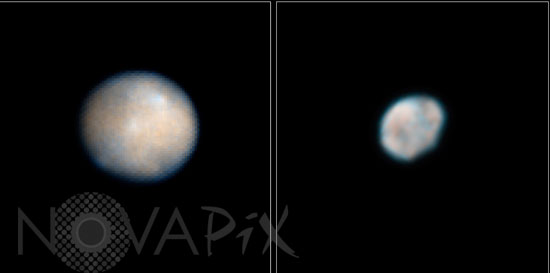Photo Agency - Astronomy - Space - Nature

Asteroids Ceres and Vesta seen by the Hubble space telescope
author: Nasa/ESA/Novapix
reference: a-ast04-10003
Image Size 300 DPI: 24 * 12 cm
These Hubble Space Telescope images of Vesta and Ceres show two of the most massive asteroids in the asteroid belt, a region between Mars and Jupiter. At least 100,000 asteroids inhabit the asteroid belt, a reservoir of leftover material from the formation of our solar-system planets 4.6 billion years ago. The International Astronomical Union named Ceres one of three dwarf planets in 2006. Ceres is round like planets in our solar system, but it does not clear debris out of its orbit as our planets do. The image at right was taken on May 14 and 16, 2007. Using Hubble, astronomers mapped Vesta's southern hemisphere, a region dominated by a giant impact crater formed by a collision billions of years ago. The crater is 285 miles (456 kilometers) across, which is nearly equal to Vesta's 330-mile (530-kilometer) diameter. The Hubble image of Ceres on the left, taken on January 2004, reveals bright and dark regions on the asteroid's surface that could be topographic features, such as craters, and/or areas containing different surface material. Ceres has a diameter of approximately 950 kilometers.
Keywords for this photo:
2007 - ACS - ASTEROID - ASTEROID BELT - ASTRONOMY - CERES - DWARF PLANET - HST - HUBBLE SPACE TELESCOPE - VESTA -
Contact : Stéphane Aubin +33-(0)9-51-26-53-76
© Novapix - All rights reserved


